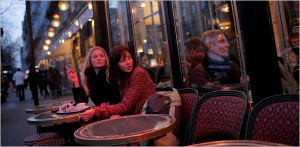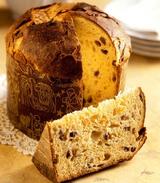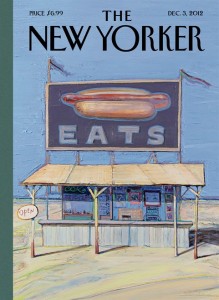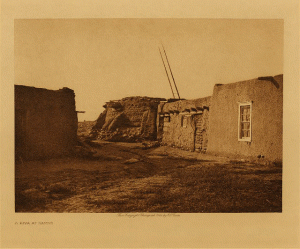December 16th, 2012 § § permalink
There are some dishes that are only good at home. Potato latkes in a restaurant are terrible. Too greasy. Not crisp. And, if crisp, the interior is mushy — more like a knish than a proper latke. Balance is never achieved. HG has often sighed for the wonders achieved by HG’s Mom. Fortunately, SJ has inherited his late grandmother’s latke skills. His are flavorful delights and HG looks forward to ingesting a dozen or so during the upcoming holiday feast. Restaurant risotto doesn’t work. If it’s reheated it gets gummy. Cooking to order isn’t cost effective. The result is an inferior product, totally unlike the creamy, lush nuttiness that HG creates by constant stirring and laser-like attention. HG has had good omelettes (in Paris) but has only had a great omelette when BSK has wielded her magic skillet.
The opposite of better-at-home food is the lovely Mexican treat: the Chimichanga — or deep fried, crisp burrito. The Chimichanga is impossible to make at home as its preparation requires the wizardry of a professional kitchen and a light touch on the deep fryer. In unskilled hands, it becomes a greasy, tasteless mess. But, when a Chimichanga is good…oh yes! Well, HG is happy to report that he has found the perfect Chimichanga. El Parasol (the wonderful casual restaurant in Pojoaque, NM, often lauded by HG) provided the treat. A perfect filling of ground beef, green chiles and cheese and a crisp exterior that shattered into phyllo-like shards when pierced by a fork. The Chimichanga was served with a scoop of guacamole resting on a mound of shredded lettuce plus a few spoonfuls of sour cream. The dish was augmented by ramekins of green and red salsa. Yes, it is an infantile word but it expresses the taste: YUM!!

December 13th, 2012 § § permalink
The United States is divided between people who love garlic and people who abhor garlic. Garlic lovers are warm hearted, intelligent, handsome. They are expert and ardent in the intimacies of the bedroom. People who hate garlic live in “gated communities,” vote Republican and believe that the Olive Garden is an ethnic restaurant. Suffice it to say that garlic-haters are not Casanovas. Anchovies are a more complex matter. HG knows many otherwise estimable people who don’t like anchovies. They don’t even like them in a Caesar Salad where they are a vital ingredient. BSK is an artist of the anchovy. She uses them in vegetable stir fries, sautes and stews where the anchovies dissolve imparting an umami flavor as they enhance the other ingredients. Anchovies are useful in larding a leg of lamb in the French provincial manner. HG likes them with roasted Piquillo peppers and a dash of olive oil. And, when HG wants some simple comfort HG makes a sauce of anchovies, garlic, Italian parsley and hot pepper flakes and pours it over some al dente linguini. Heavily salted anchovies are sold in crates in some Italian neighborhood groceries. They have to be soaked in water and rinsed. HG has never managed to get it right. Instead, HG buys high quality anchovy filets in jars rather than the tinned variety.

December 12th, 2012 § § permalink
HG has not smoked a cigarette or cigar or puffed on a pipe (always hated it) in 20 years. A battle with cancer (won by HG due to the extraordinary skills of a renowned surgeon) snuffed out the habit. HG is startled that smoking is not missed. No Marlboros with morning coffee. No Gitanes with red wine. No Sobranies with pre-dinner Martinis. No Upmann Brevas (Maduro leaf) with after-dinner Port. And no lovely cigarettes while writing, reading, thinking, waiting, etc. Still love, with passion, food and drink — even without tobacco accompaniment. HG has been pleased that trattorias in Italy and bistros in Paris are smoke free. BSK would complain that her hair and clothes smelled of cigarettes after a long, wine-filled dinner at these excellent eateries. In Paris these days, smokers (and there are lots of them) are relegated to the terraces. Passing through a terrace to enter a bistro is like walking through a mini-forest fire. Bistro owners, however, are considerate of the smokers. Many terraces are now heated even though hardy, flimsily dressed Parisiennes would gladly ignore biting winds in order to indulge in their unfortunate addiction.

December 10th, 2012 § § permalink
Last week New Yorkers were shocked (and rightfully so) by the demented act of a homeless man who shoved a subway commuter to his death beneath an ongoing train. One more event to add to the nervous fears felt by many. The New York Post exploited the event by running a cover photo of the victim before his death under the lurid headline: “This man is about to die.” A new low even for Murdoch gutter journalism. The New York Times ran a searching and brilliant analysis of New York Post journalistic ethics by media reporter and critic David Carr. It is a must read. All of this made HG recall his days as an editor at Hearst’s International News Photos with hundreds of photographers throughout the world at his disposal. HG was 23 years old at the time. One midnight, as HG manned the Night Desk, HG received a tip from a police source that a man was perched on the rail of the George Washington Bridge and threatening suicide. HG couldn’t contact his staff photographers so HG raced to the city desk of the Daily Mirror, the Hearst tabloid which shared the same floor with INP. The Mirror had received the same tip and had a young photographer, Bob Wendlinger, on the scene. They had reached him on his two way radio as he was driving to his home minutes from the Bridge. A priest had the suicide by the collar and a police officer had his arm outstretched for the man to grasp. On his knees, Bob focused his Speed Graphic flash camera on the man. The policeman warned Bob that if the flash of his camera caused the man to jump he would be charged with homicide. The suicide said: “My hands are cold,” wrenched free from the priest and fell to his death in the waters below. Bob took the photo at the instant the man let go. Bob wasn’t sure he got it so everyone at the Mirror paced in suspense as the film was developed. When we looked at the dripping negative on the light screen we knew Bob had captured a classic image: Clutching hands above. A falling man with his face contorted by the knowledge of imminent death. The photo was a sensation. Life Magazine ran it in a double page spread and it was reproduced in newspapers and magazines throughout the world. Nobody connected with that photograph ever questioned the moral questions aroused by its publication. The world has changed.

December 9th, 2012 § § permalink
On a chill morning nothing beats a steaming bowl of congee (also known as jook). When HG was resident in a Vancouver loft, HG often walked to nearby Congee Noodle House for a bowl (accompanied by pork rice crepes, shrimp wontons or chile fried squid). There were some 20 varieties of congee served there. Most of the Chinese diners specified an ominous, black “thousand year egg” be popped in their bowl, HG opted for chopped oysters, black mushrooms or large prawns. The congee was topped with gingko nuts. It takes a bit of time to make proper congee but HG has discovered a time saving remedy. H Mart, the Korean grocery chain and online purveyor of all foods Korean, offers packaged Ottogi Rice Porridge. Boil a package with four cups of water (stir until you get the right consistency) and you have a very pleasant pot of jook. HG had some this morning accompanied by a few very good steamed pork buns produced by the O’ Tasty Food Co. HG added some chopped Pacific oysters to his congee plus a dash of the inevitable sriracha. Topped it with some Planter’s Cocktail Peanuts (sounds odd but tastes great). Was instantly transported to Vancouver, or as the natives dub it, Van Kong.

December 8th, 2012 § § permalink
Yes, ’tis the season to be jolly and adding to seasonal merriment is Panettone. The Italian sweet bread, which originated in Milan, makes its annual holiday appearance in an oddly shaped box. The bread is yeasty, fragrant and studded with raisins and candied fruit. Delicious. Like a fruit cake that is actually good to eat. It is a Christmas staple not only in Italy, but also in Brazil, Argentina and Uruguay. Italians like it for dessert (topped by a scoop of mascarpone) with a glass of sweet wine like Moscato d’Asti. HG likes it for breakfast. Gently warmed and served with marmalade or a drizzle of maple syrup. Good for dessert with vanilla ice cream. You can buy the Bonifante imported Panettone at Zabar’s (expensive); a cherry Panettone at Dean &Deluca (very expensive, naturally); a tinned one with glazed chesnuts at Williams-Sonoma (expensive) and the house brand one at Trader Joe’s (very cheap). Penny pinching HG goes for TJ’s version.

December 6th, 2012 § § permalink
The annual New Yorker Food Issue is out and has some good reading for the food obsessed. Calvin Trillin has a piece on the cuisine of Oaxaca, Mexico. Makes you want to grab the next plane to that city even if you have no desire to eat caterpillars and worms, two local specialties. Mimi Sheraton does a riff on sausages including a description of a goose and goose liver sausage she ate in Hamburg some years ago. Very appetite provoking. HG has always felt Mimi Sheraton was the best of the New York Times restaurant reviewers. She reigned between 1975-1983. She was fair, balanced and funny. She concentrated on a restaurant’s food rather than going on and on about the hipness (or lack) of the restaurant’s clientele. Sheraton has written some good books. From My Mother’s Kitchen is a delightful memoir and very evocative of a vanished New York. As a plus, it has some good, down to earth recipes. HG liked Craig Claiborne, the original Times reviewer. However, like many a New York transplant from the South, Claiborne never met a Jewish delicatessen or Chinese restaurant he didn’t love. The man had great judgement in matters concerning French cuisine. But, when it came to pastrami or shrimp in black bean sauce — Fuhgeddabout it!!

December 5th, 2012 § § permalink
Nambe is a town just a few miles north of HG and BSK’s home in New Mexico. You might recognize the name from the unique metal alloy designs marketed under the Nambé label. Two interesting women, our good friends Vicki B. and Sarah N., are temporarily domiciled in a historic adobe dwelling tucked away in a corner of the Nambe Pueblo. The house is not faux Southwest. It’s the real thing. A shepherd’s fireplace (shepherd sleeps on a shelf above the fireplace). Old dark beams. Thickly plastered walls. Low ceilings. A delightful place to be on a chilly evening. The women, though not puritanical, are health conscious. Dinner was cauliflower soup, creatively spiced and soothing. Then a lovely chunk of crisped chicken with sliced sweet potatoes in a sauce that had hints of New Mexico chiles. Dessert was a melange of Greek yogurt and stewed and fresh seasonal fruit. A goat blue cheese from a Santa Fe Farmers Market artisan helped the group finish off the red wine. The meal was preceded by New Zealand Sauvignon Blanc and smoked trout consumed in front of a copper hooded raised fireplace. The meal was as healthy as it was delicious. Adding to the delights of the evening were Vicki and Sarah’s accounts of their mental and spiritual adventures. Warm and stimulating pleasures on a cold night.

December 4th, 2012 § § permalink
HG has very mixed, odd feelings about that estimable vegetable — fennel. Does not like it roasted. Does not like it slicked thickly in salads. However, shaved paper-thin and mixed with slices of radish and young turnips, doused with good Sicilian olive oil and plenty of sea salt and cracked pepper — a very nice appetizer. Fennel seeds are worthy additions to traditional Italian sausages — the kind that used to be sold (grilled with onions and peppers) off Greenwich Village trucks. Frankies Spuntino in Brooklyn does a very good fennel salad which HG and BSK have been unable to duplicate at home. In HG’s opinion, fennel is at its best braised in chicken broth with plenty of butter. Serve it with poached or grilled salmon. Perfect. Radicchio is another vegetable that arouses mixed emotions. Don’t like it raw but grilled it’s a treat. Belgian endive is always wonderful — leaves in salads; braised; grilled lightly or served in a gratin with cream and cheese. No ambiguity. An odd thought about fennel. The Italian word for fennel is finocchio. This is also an Italian derogatory term for homosexuals. (Recall the scene in “Godfather One” where Marlon Brando upbraids the Sinatra-like singer for acting like a “Hollywood finocchio”?). Don’t understand the derivation.

December 2nd, 2012 § § permalink
HG’s pal, Bill Schuck, sent him a copy of The Deli Man, a clip from a longer film. Nice nostalgic stuff about Jewish delis with cameos from Larry King, Alan Dershowitz and other pastrami fanatics. Shocking fact. There were once 1,550 Jewish delis in the five boroughs of New York. There are now only 150 in all of North America; that said many staples of the Jewish Deli (pastrami, chopped liver, etc.) have become part of the mainstream eating culture of the United States. According to informed opinion, the best Jewish deli in the United States is Langer’s, located in a gritty Los Angeles neighborhood. The proprietor of Langer’s is gloomy about the future of the deli. Jewish kids prefer hamburgers. Sad. They will never know the glory of a heartburn produced by a bowl of matzo ball soup followed by an overstuffed pastrami sandwich.










